Construction of an Ecological Security Pattern in Rapidly Urbanizing Areas Based on Ecosystem Sustainability, Stability, and Integrity
Abstract
:1. Introduction
2. Materials and Methods
2.1. Study Area
2.2. Data Sources
3. Research Framework and Methods
3.1. Research Framework
3.2. Methods
3.2.1. Identification of Ecosources
3.2.2. Extraction of Ecocorridors
3.2.3. Identification of Econodes
3.2.4. Construction of Ecological Resistance
3.2.5. Ecosystem Service Function
3.2.6. Ecological Sensitivity
3.2.7. Landscape Connectivity
3.2.8. Landuse Dynamic Degree
4. Results
4.1. Landuse Dynamics in Nanchang
4.2. ESF Importance and Ecological Sensitivity
4.3. Nanchang’s Ecosources
4.4. Nanchang’s Ecocorridors
4.5. Nanchang’s ESP
5. Discussion
5.1. Process of Urbanization
5.2. Evaluation of ESP
5.3. Optimization of ESP
5.4. Limitations and Future Work
6. Conclusions
Author Contributions
Funding
Data Availability Statement
Acknowledgments
Conflicts of Interest
References
- Vaz, S.; Manes, S.; Khattar, G.; Mendes, M.; Silveira, L.; Mendes, E.; Rodrigues, E.D.; Gama-Maia, D.; Lorini, M.L.; Macedo, M.; et al. Global meta-analysis of urbanization stressors on insect abundance, richness, and traits. Sci. Total Environ. 2023, 903, 165967. [Google Scholar] [CrossRef]
- Gao, Y.Y.; Wang, S.T.; Zhang, C.X.; Xing, C.Z.; Tan, W.; Wu, H.Y.; Niu, X.H.; Liu, C. Assessing the impact of urban form and urbanization process on tropospheric nitrogen dioxide pollution in the Yangtze River Delta, China. Environ. Pollut. 2023, 336, 122436. [Google Scholar] [CrossRef]
- Yu, G.T.; Liu, T.W.; Wang, Q.; Li, T.; Li, X.J.; Song, G.H.; Feng, Y.G. Impact of Land Use/Land Cover Change on Ecological Quality during Urbanization in the Lower Yellow River Basin: A Case Study of Jinan City. Remote Sens. 2022, 14, 6273. [Google Scholar] [CrossRef]
- Li, Z.Z.; Hu, B.A.; Ren, Y.F. The Supply-Demand Budgets of Ecosystem Service Response to Urbanization: Insights from Urban-Rural Gradient and Major Function-Oriented Areas. Remote Sens. 2022, 14, 5670. [Google Scholar] [CrossRef]
- Qiao, W.Y.; Huang, X.J. The impact of land urbanization on ecosystem health in the Yangtze River Delta urban agglomerations, China. Cities 2022, 130, 103981. [Google Scholar] [CrossRef]
- Hahs, A.K.; Fournier, B.; Aronson, M.F.J.; Nilon, C.H.; Herrera-Montes, A.; Salisbury, A.B.; Threlfall, C.G.; Rega-Brodsky, C.C.; Lepczyk, C.A.; La Sorte, F.A.; et al. Urbanisation generates multiple trait syndromes for terrestrial animal taxa worldwide. Nat. Commun. 2023, 14, 4751. [Google Scholar] [CrossRef] [PubMed]
- Grossman, D. We are killing this ecosystem’: The scientists tracking the Amazon’s fading health. Nature 2023, 620, 712–716. [Google Scholar] [CrossRef] [PubMed]
- Zhang, R.; Wang, C.L.; Xiong, Y.C. Ecological security assessment of China based on the Pressure-State-Response framework. Ecol. Indic. 2023, 154, 110647. [Google Scholar] [CrossRef]
- Liu, B.; Zhang, F.L.; Qin, X.S.; Wu, Z.; Wang, X.L.; He, Y.Y. Spatiotemporal assessment of water security in China: An integrated supply-demand coupling model. J. Clean. Prod. 2021, 321, 128955. [Google Scholar] [CrossRef]
- Yi, D.; Guo, X.; Han, Y.; Guo, J.; Ou, M.H.; Zhao, X.M. Coupling Ecological Security Pattern Establishment and Construction Land Expansion Simulation for Urban Growth Boundary Delineation: Framework and Application. Land 2022, 11, 359. [Google Scholar] [CrossRef]
- Gao, M.H.; Li, C.; Zhao, J.; Zhao, H. Identification of ecological security pattern based on ecosystem service supply and demand in the Yangtze River Delta, China. Geocarto Int. 2023, 38, 2252787. [Google Scholar] [CrossRef]
- Mathys, A.S.; van Vianen, J.; Rowland, D.; Narulita, S.; Palomo, I.; Pascual, U.; Sutherland, I.J.; Ahammad, R.; Sunderland, T. Participatory mapping of ecosystem services across a gradient of agricultural intensification in West Kalimantan, Indonesia. Ecosyst. People 2023, 19, 2174685. [Google Scholar] [CrossRef]
- Sadeghi, S.H.; Silabi, M.Z.; Sadrabad, H.S.; Riahi, M.; Tabatabaei, S.M. Watershed health and ecological security modeling using anthropogenic, hydrologic, and climatic factors. Nat. Resour. Model. 2023, 36, e12371. [Google Scholar] [CrossRef]
- Tang, H.J.; Hou, K.; Wu, S.Q.; Liu, J.W.; Ma, L.X.; Li, X.X. Interpretation of the coupling mechanism of ecological security and urbanization based on a Computation-Verification-Coupling framework: Quantitative analysis of sustainable development. Ecotoxicol. Environ. Saf. 2023, 263, 115294. [Google Scholar] [CrossRef] [PubMed]
- Liu, X.Y.; Su, Y.; Li, Z.G.; Zhang, S. Constructing ecological security patterns based on ecosystem services trade-offs and ecological sensitivity: A case study of Shenzhen metropolitan area, China. Ecol. Indic. 2023, 154, 110626. [Google Scholar] [CrossRef]
- Li, Y.M.; Zhao, J.Z.; Yuan, J.; Ji, P.K.; Deng, X.L.; Yang, Y.M. Constructing the Ecological Security Pattern of Nujiang Prefecture Based on the Framework of “Importance-Sensitivity-Connectivity”. Int. J. Environ. Res. Public Health 2022, 19, 10869. [Google Scholar] [CrossRef] [PubMed]
- Nie, W.B.; Xu, B.; Yang, F.; Shi, Y.; Liu, B.T.; Wu, R.W.; Lin, W.; Pei, H.; Bao, Z.Y. Simulating future land use by coupling ecological security patterns and multiple scenarios. Sci. Total Environ. 2023, 859, 160262. [Google Scholar] [CrossRef] [PubMed]
- Cao, X.F.; Liu, Z.S.; Li, S.J.; Gao, Z.J. Integrating the Ecological Security Pattern and the PLUS Model to Assess the Effects of Regional Ecological Restoration: A Case Study of Hefei City, Anhui Province. Int. J. Environ. Res. Public Health 2022, 19, 6640. [Google Scholar] [CrossRef] [PubMed]
- Chen, Z.Z.; Huang, M.; Zhu, D.Y.; Altan, O. Integrating Remote Sensing and a Markov-FLUS Model to Simulate Future Land Use Changes in Hokkaido, Japan. Remote Sens. 2021, 13, 2621. [Google Scholar] [CrossRef]
- Kang, J.M.; Zhang, X.; Zhu, X.W.; Zhang, B.L. Ecological security pattern: A new idea for balancing regional development and ecological protection. A case study of the Jiaodong Peninsula, China. Glob. Ecol. Conserv. 2021, 26, e01472. [Google Scholar] [CrossRef]
- Huang, J.F.; Wang, R.H.; Zhang, H.Z. Analysis of patterns and ecological security trend of modern oasis landscapes in Xinjiang, China. Environ. Monit. Assess. 2007, 134, 411–419. [Google Scholar] [CrossRef] [PubMed]
- Wei, H.; Zhu, H.; Chen, J.; Jiao, H.Y.; Li, P.H.; Xiong, L.Y. Construction and Optimization of Ecological Security Pattern in the Loess Plateau of China Based on the Minimum Cumulative Resistance (MCR) Model. Remote Sens. 2022, 14, 5906. [Google Scholar] [CrossRef]
- Peng, J.; Yang, Y.; Liu, Y.X.; Hu, Y.N.; Du, Y.Y.; Meersmans, J.; Qiu, S.J. Linking ecosystem services and circuit theory to identify ecological security patterns. Sci. Total Environ. 2018, 644, 781–790. [Google Scholar] [CrossRef] [PubMed]
- Yu, H.R.; Gu, X.C.; Liu, G.H.; Fan, X.; Zhao, Q.; Zhang, Q. Construction of Regional Ecological Security Patterns Based on Multi-Criteria Decision Making and Circuit Theory. Remote Sens. 2022, 14, 527. [Google Scholar] [CrossRef]
- Cui, X.F.; Deng, W.; Yang, J.X.; Huang, W.; de Vries, W.T. Construction and optimization of ecological security patterns based on social equity perspective: A case study in Wuhan, China. Ecol. Indic. 2022, 136, 108714. [Google Scholar] [CrossRef]
- Jin, L.J.; Xu, Q.L.; Yi, J.H.; Zhong, X.C. Integrating CVOR-GWLR-Circuit model into construction of ecological security pattern in Yunnan Province, China. Environ. Sci. Pollut. Res. 2022, 29, 81520–81545. [Google Scholar] [CrossRef]
- Tang, B.T.; Wang, H.; Peng, L.X.; Wang, Z.Z.; Liu, J.M.; Zhang, L.W.; Jiao, L. Integrating ecosystem organization, quality and services indicators in the ecological security assessment. Land Degrad. Dev. 2023, 34, 4561–4574. [Google Scholar] [CrossRef]
- Wang, L.; Chang, J.X.; He, B.; Guo, A.J.; Wang, Y.M. Analysis of oasis land ecological security and influencing factors in arid areas. Land Degrad. Dev. 2023, 34, 3550–3567. [Google Scholar] [CrossRef]
- Liang, Y.Q.; Liu, H.Y.; Chiaka, J.C.; Jiang, C.T.; Wei, N.N.; Liang, Y.H. Spatiotemporal patterns and driving mechanism of tourism ecological security in Guangxi, China. Front. Ecol. Evol. 2023, 11, 1163498. [Google Scholar] [CrossRef]
- Zhang, Z.; Hu, B.Q.; Jiang, W.G.; Qiu, H.H. Construction of ecological security pattern based on ecological carrying capacity assessment 1990–2040: A case study of the Southwest Guangxi Karst- Beibu Gulf. Ecol. Model. 2023, 479, 110322. [Google Scholar] [CrossRef]
- Zeng, Y.F.; Meng, S.H.; Wu, Q.; Mei, A.S.; Bu, W.Y. Ecological water security impact of large coal base development and its protection. J. Hydrol. 2023, 619, 129319. [Google Scholar] [CrossRef]
- Zhang, Y.X.; Ma, Y.G.; Xu, Z.L. Construction of ecological security patterns based on multi-scenario simulations in arid and semi-arid areas in Northwest China. Int. J. Sust. Dev. World 2023, 30, 699–712. [Google Scholar] [CrossRef]
- Jia, Q.Q.; Jiao, L.M.; Lian, X.H.; Wang, W.L. Linking supply-demand balance of ecosystem services to identify ecological security patterns in urban agglomerations. Sustain. Cities Soc. 2023, 92, 104497. [Google Scholar] [CrossRef]
- Wang, C.X.; Yu, C.Y.; Chen, T.Q.; Feng, Z.; Hu, Y.C.; Wu, K.N. Can the establishment of ecological security patterns improve ecological protection? An example of Nanchang, China. Sci. Total Environ. 2020, 740, 140051. [Google Scholar] [CrossRef] [PubMed]
- Lai, X.Y.; Yu, H.R.; Liu, G.H.; Zhang, X.X.; Feng, Y.; Ji, Y.W.; Zhao, Q.; Jiang, J.Y.; Gu, X.C. Construction and Analysis of Ecological Security Patterns in the Southern Anhui Region of China from a Circuit Theory Perspective. Remote Sens. 2023, 15, 1385. [Google Scholar] [CrossRef]
- Lu, T.; Li, C.J.; Zhou, W.X.; Liu, Y.X. Fuzzy Assessment of Ecological Security on the Qinghai-Tibet Plateau Based on Pressure-State-Response Framework. Remote Sens. 2023, 15, 1293. [Google Scholar] [CrossRef]
- Wang, S.R.; Song, Q.; Zhao, J.Y.; Lu, Z.B.; Zhang, H.X. Identification of Key Areas and Early-Warning Points for Ecological Protection and Restoration in the Yellow River Source Area Based on Ecological Security Pattern. Land 2023, 12, 1643. [Google Scholar] [CrossRef]
- Zhang, H.B.; Yan, Q.Q.; Xie, F.F.; Ma, S.C. Evaluation and Prediction of Landscape Ecological Security Based on a CA-Markov Model in Overlapped Area of Crop and Coal Production. Land 2023, 12, 207. [Google Scholar] [CrossRef]
- Yang, X.F.; Cai, H.S.; Zhang, X.L.; Zuo, T.Y.; Chen, L.T. Spatial-temporal evolution of ecosystem service value and its driving factors in the Great Nanchang Metropolitan Area. Chin. J. Ecol. 2023, 1–13. Available online: https://kns.cnki.net/kcms2/detail/21.1148.Q.20230606.1534.008.html (accessed on 23 April 2023).
- Hu, C.G.; Wang, Z.Y.; Huang, G.L.; Ding, Y.C. Construction, Evaluation, and Optimization of a Regional Ecological Security Pattern Based on MSPA-Circuit Theory Approach. Int. J. Environ. Res. Public Health 2022, 19, 16184. [Google Scholar] [CrossRef]
- Wu, Y.D.; Han, Z.Y.; Meng, J.J.; Zhu, L.K. Circuit theory-based ecological security pattern could promote ecological protection in the Heihe River Basin of China. Environ. Sci. Pollut. Res. 2023, 30, 27340–27356. [Google Scholar] [CrossRef] [PubMed]
- Wang, S.; Wu, M.Q.; Hu, M.M.; Xia, B.C. Integrating ecosystem services and landscape connectivity into the optimization of ecological security pattern: A case study of the Pearl River Delta, China. Environ. Sci. Pollut. Res. 2022, 29, 76051–76065. [Google Scholar] [CrossRef] [PubMed]
- Zhang, Y.L.; Zhao, Z.Y.; Yang, Y.Y.; Fu, B.J.; Ma, R.M.; Lue, Y.H.; Wu, X. Identifying ecological security patterns based on the supply, demand and sensitivity of ecosystem service: A case study in the Yellow River Basin, China. J. Environ. Manag. 2022, 315, 115158. [Google Scholar] [CrossRef] [PubMed]
- Hu, Q.; Huang, H.P.; Kung, C.C. Ecological impact assessment of land use in eco-industrial park based on life cycle assessment: A case study of Nanchang High-tech development zone in China. J. Clean. Prod. 2021, 300, 126816. [Google Scholar] [CrossRef]
- Huang, M.; Gong, D.H.; Lin, H.; Hu, B.S.; Chen, J.H.; Xiao, C.J.; Luo, J.; Qi, S.H.; Altan, O. Does COVID-19 Affect the Accessibility of Outdoor Sports Venues? A Case Study in Nanchang, China. Land 2023, 12, 158. [Google Scholar] [CrossRef]
- Wang, W.Q.; Xu, Q.Q.; Xia, G.L.; Dong, X.; Bao, C.K. Constructing a paradigm of environmental impact assessment under the new era of ecological civilization in China. Environ. Impact Assess. Rev. 2023, 99, 107021. [Google Scholar] [CrossRef]
- Cai, C.Y.M.; Huang, F.; Yang, Y.Y.; Yu, S.Q.; Wang, S.J.; Fan, Y.L.; Wang, Q.; Liu, W. Effects of Glomalin-Related Soil Protein Driven by Root on Forest Soil Aggregate Stability and Carbon Sequestration during Urbanization in Nanchang, China. Plants 2023, 12, 1847. [Google Scholar] [CrossRef]
- Meng, B.; Wang, X.X.; Zhang, Z.F.; Huang, P. Spatio-Temporal Pattern and Driving Force Evolution of Cultivated Land Occupied by Urban Expansion in the Chengdu Metropolitan Area. Land 2022, 11, 1458. [Google Scholar] [CrossRef]
- Jian, Y.K. Landscape ecological security patterns in biological conservation. Acta Ecol. Sin. 1999, 19, 8–15. [Google Scholar]
- Lv, L.; Zhang, S.H.; Zhu, J.; Wang, Z.M.; Wang, Z.; Li, G.Q.; Yang, C. Ecological Restoration Strategies for Mountainous Cities Based on Ecological Security Patterns and Circuit Theory: A Case of Central Urban Areas in Chongqing, China. Int. J. Environ. Res. Public Health 2022, 19, 16505. [Google Scholar] [CrossRef]
- Zhang, Y.L.; Cao, Y.R.; Huang, Y.T.; Wu, J.Y. Integrating ecosystem services and complex network theory to construct and optimize ecological security patterns: A case study of Guangdong-Hong Kong-Macao Greater Bay Area, China. Environ. Sci. Pollut. Res. 2023, 30, 76891–76910. [Google Scholar] [CrossRef] [PubMed]
- Lai, S.H.; Sha, J.M.; Eladawy, A.; Li, X.M.; Wang, J.L.; Kurbanov, E.; Lin, Z.J.; Wu, L.B.; Han, R.; Su, Y.C. Evaluation of ecological security and ecological maintenance based on pressure-state-response (PSR) model, case study: Fuzhou city, China. Hum. Ecol. Risk Assess. 2022, 28, 734–761. [Google Scholar] [CrossRef]
- Fu, Y.H.; Huang, M.; Gong, D.H.; Lin, H.; Fan, Y.W.; Du, W.Y. Dynamic Simulation and Prediction of Carbon Storage Based on Land Use/Land Cover Change from 2000 to 2040: A Case Study of the Nanchang Urban Agglomeration. Remote Sens. 2023, 15, 4645. [Google Scholar] [CrossRef]
- Zhang, H.; Ye, C. Around Poyang Lake importance Evaluation of Ecological Protection and Spatial Pattern of Urban Agglomeration. Bull. Soil Water Conserv. 2023, 43, 224–234. [Google Scholar] [CrossRef]
- Zhao, L.; Wei, X.J.; Cheng, P.G.; Xie, M.R.; Wang, H.M. Analysis of landscape fragmentation and driving factors in greater Nanchang metropolitan area. Sci. Surv. Mapp. 2022, 47, 181–191, 223. [Google Scholar] [CrossRef]
- Li, Y.; Mi, W.J.; Ji, L.; He, Q.S.; Yang, P.H.; Xie, S.L.; Bi, Y.H. Urbanization and agriculture intensification jointly enlarge the spatial inequality of river water quality. Sci. Total Environ. 2023, 878, 162559. [Google Scholar] [CrossRef] [PubMed]
- Bindajam, A.A.; Mallick, J.; Hang, H.T. Assessing landscape fragmentation due to urbanization in English Bazar Municipality, Malda, India, using landscape metrics. Environ. Sci. Pollut. Res. 2023, 30, 68716–68731. [Google Scholar] [CrossRef]
- Cumming, G.S.; Buerkert, A.; Hoffmann, E.M.; Schlecht, E.; von Cramon-Taubadel, S.; Tscharntke, T. Implications of agricultural transitions and urbanization for ecosystem services. Nature 2014, 515, 50–57. [Google Scholar] [CrossRef]
- Hu, Y.C.; Liu, Y.; Yan, Z.Y. Research Regarding the Coupling and Coordination Relationship between New Urbanization and Ecosystem Services in Nanchang. Sustainability 2022, 14, 15041. [Google Scholar] [CrossRef]
- Michishita, R.; Jiang, Z.B.; Xu, B. Monitoring two decades of urbanization in the Poyang Lake area, China through spectral unmixing. Remote Sens. Environ. 2012, 117, 3–18. [Google Scholar] [CrossRef]
- Wang, Z.F. Evolving landscape-urbanization relationships in contemporary China. Landsc. Urban Plan. 2018, 171, 30–41. [Google Scholar] [CrossRef]
- Xiang, H.X.; Zhang, J.; Mao, D.H.; Wang, M.; Yu, F.D.; Wang, Z.M.; Li, H.Y. Optimizing ecological security patterns considering zonal vegetation distribution for regional sustainability. Ecol. Eng. 2023, 194, 107055. [Google Scholar] [CrossRef]
- Wu, W.J.; Zhao, S.; Guo, J.; Ou, M.H.; Ding, G.Q. Construction and optimization of ecological security pattern based on the circuit theory: A case study of Hohhot City. Environ. Sci. Pollut. Res. 2023, 30, 89597–89615. [Google Scholar] [CrossRef] [PubMed]
- Hu, X.; Fu, C. Dynamic Analysis of Ecological Service Function Value for Urban Green Space in Nanchang. Acta Agric. Univ. Jiangxiensis 2014, 36, 230–237. [Google Scholar] [CrossRef]
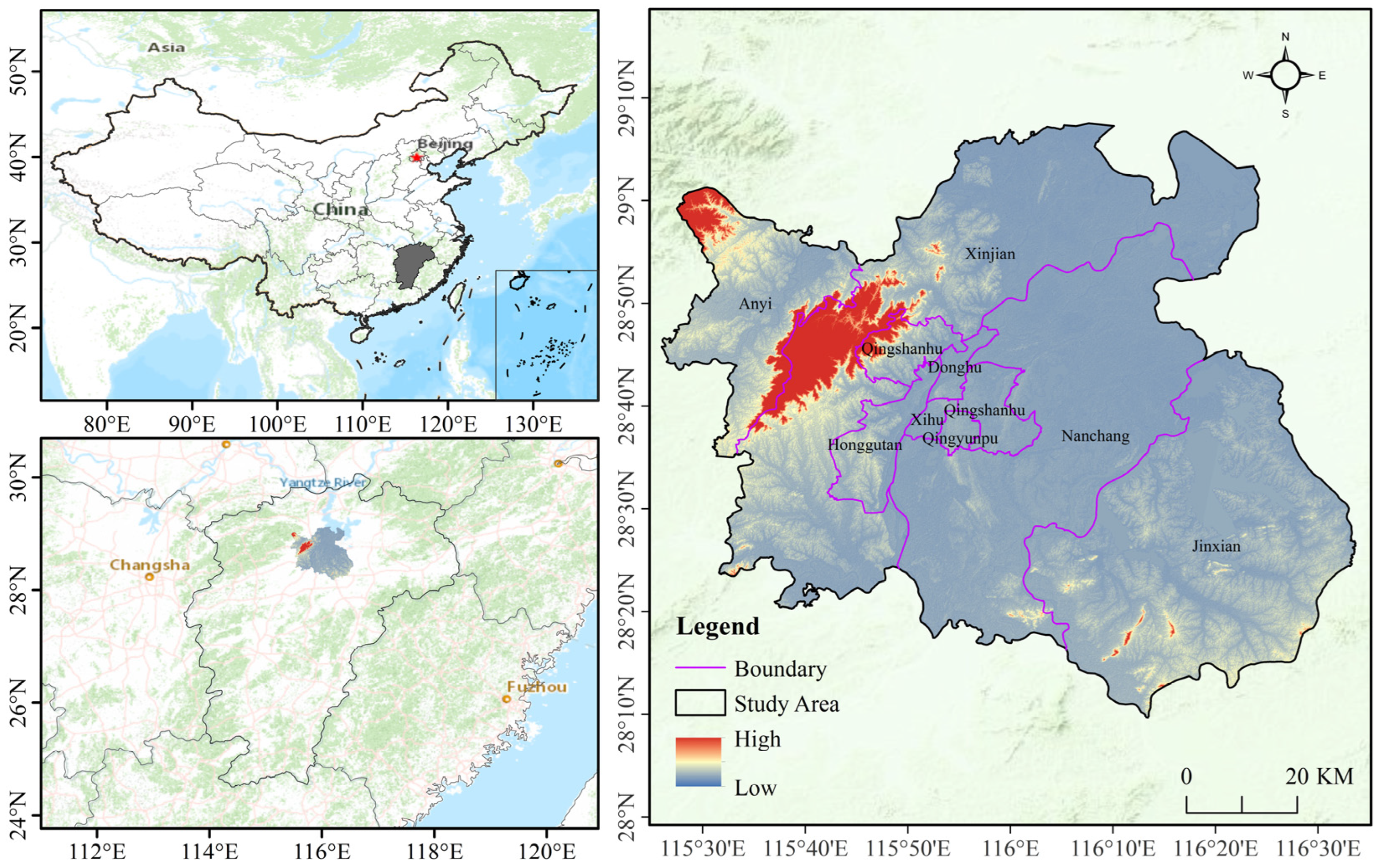
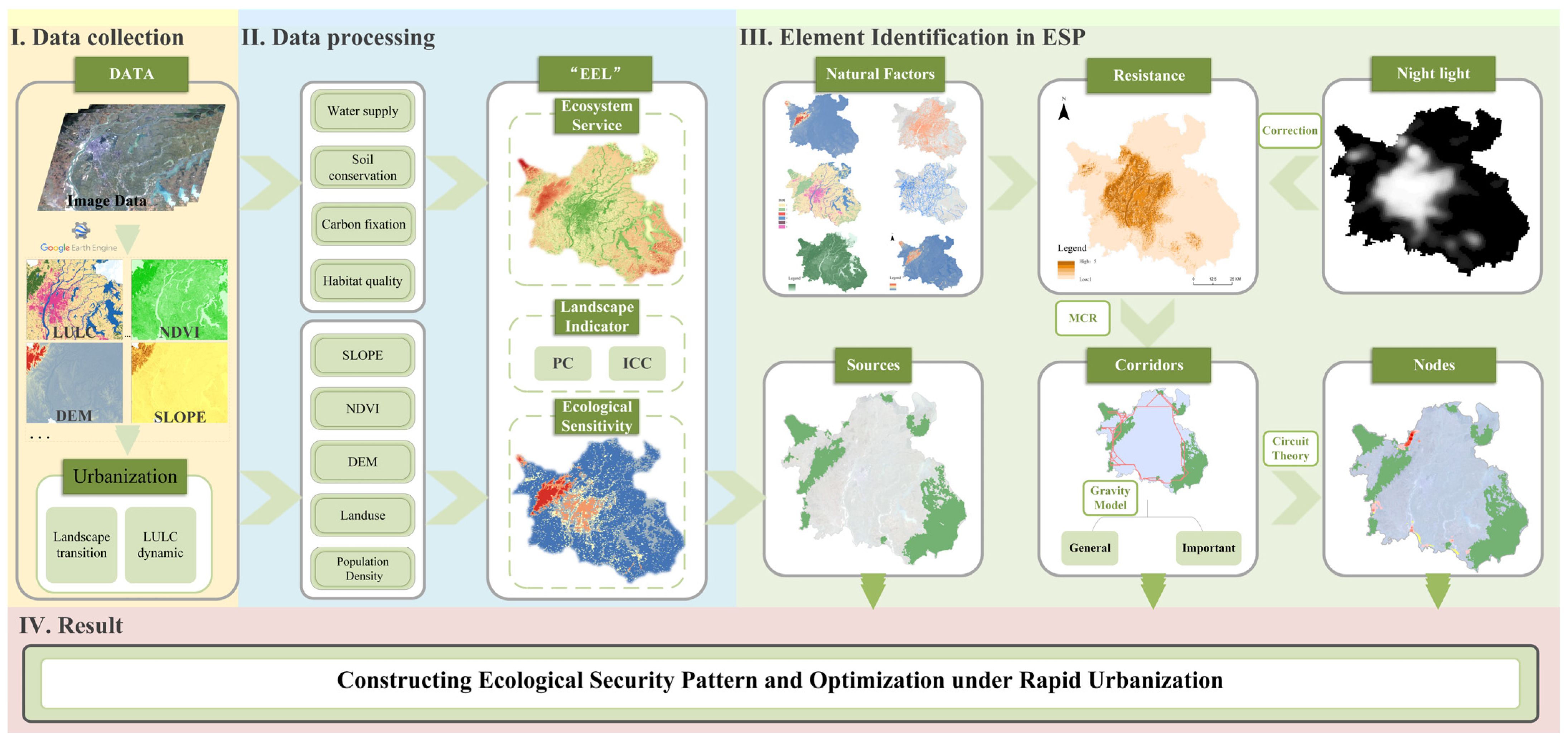
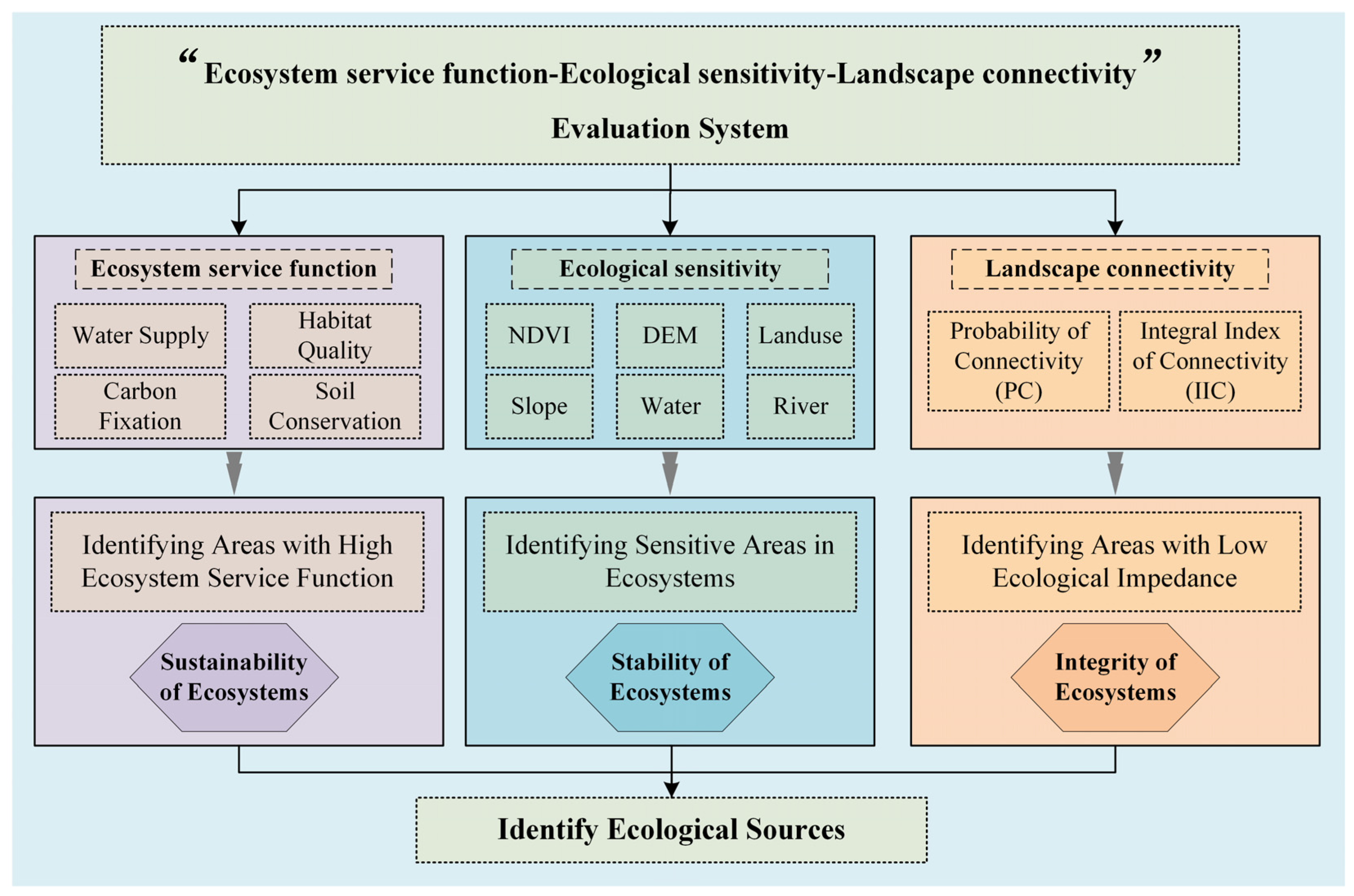

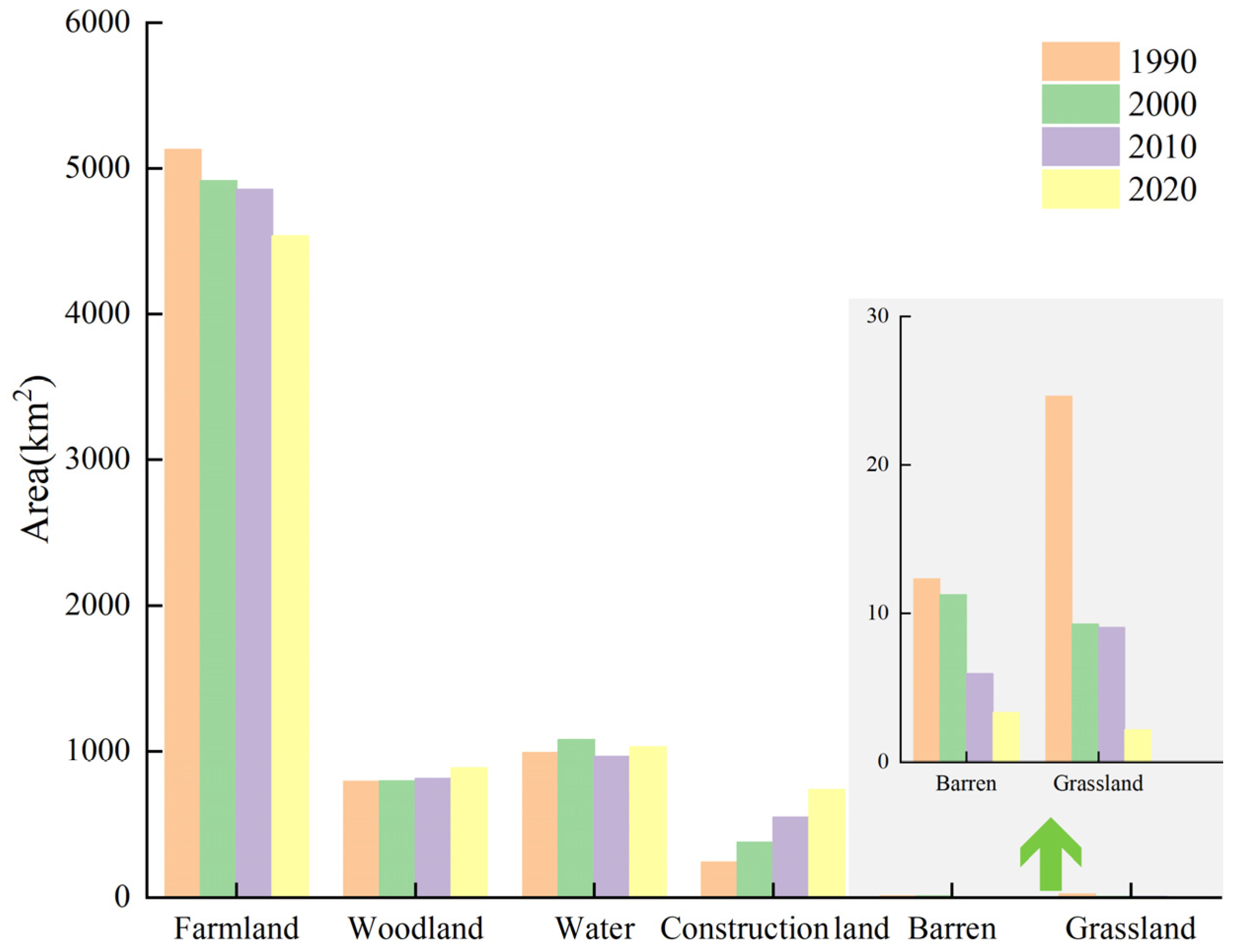
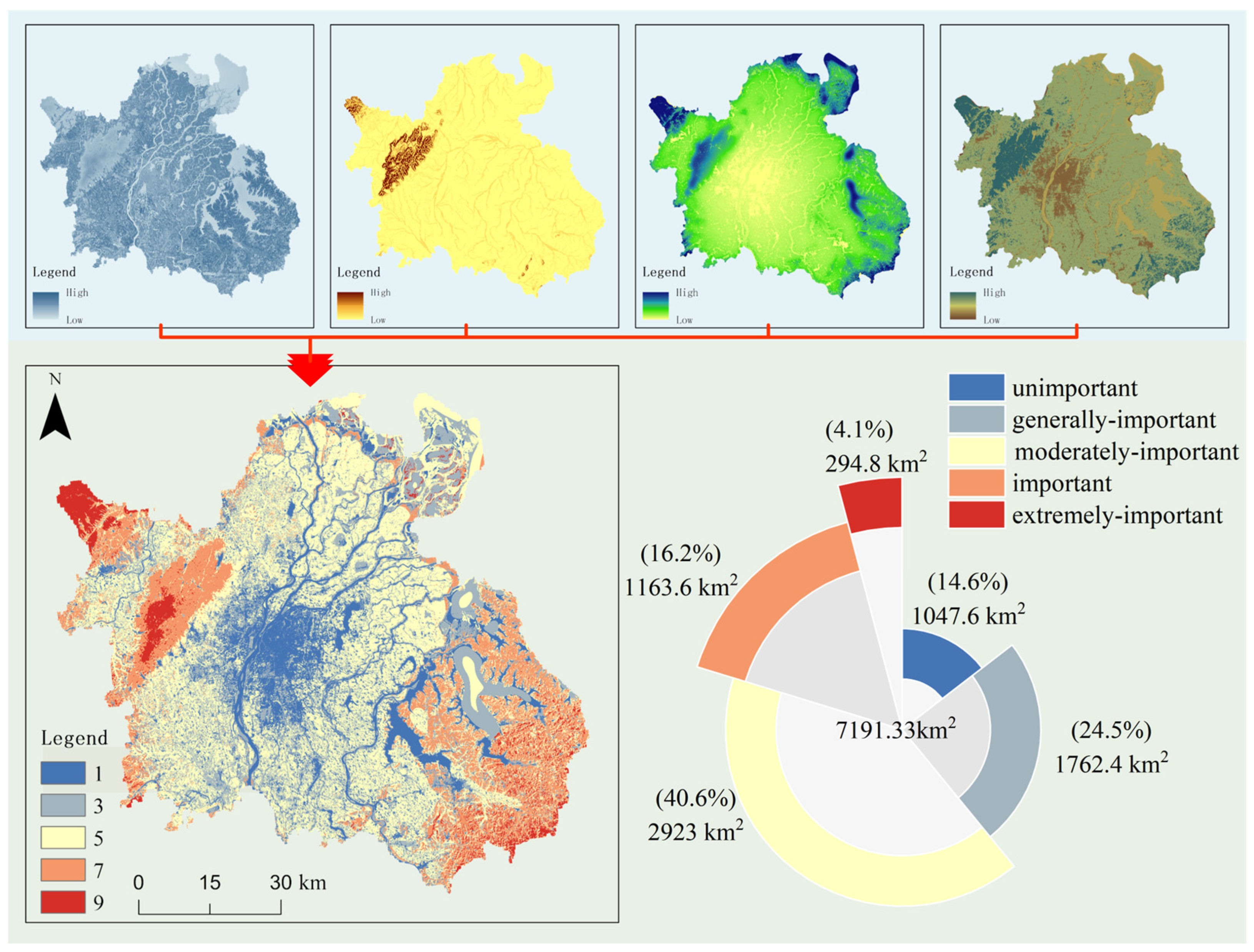
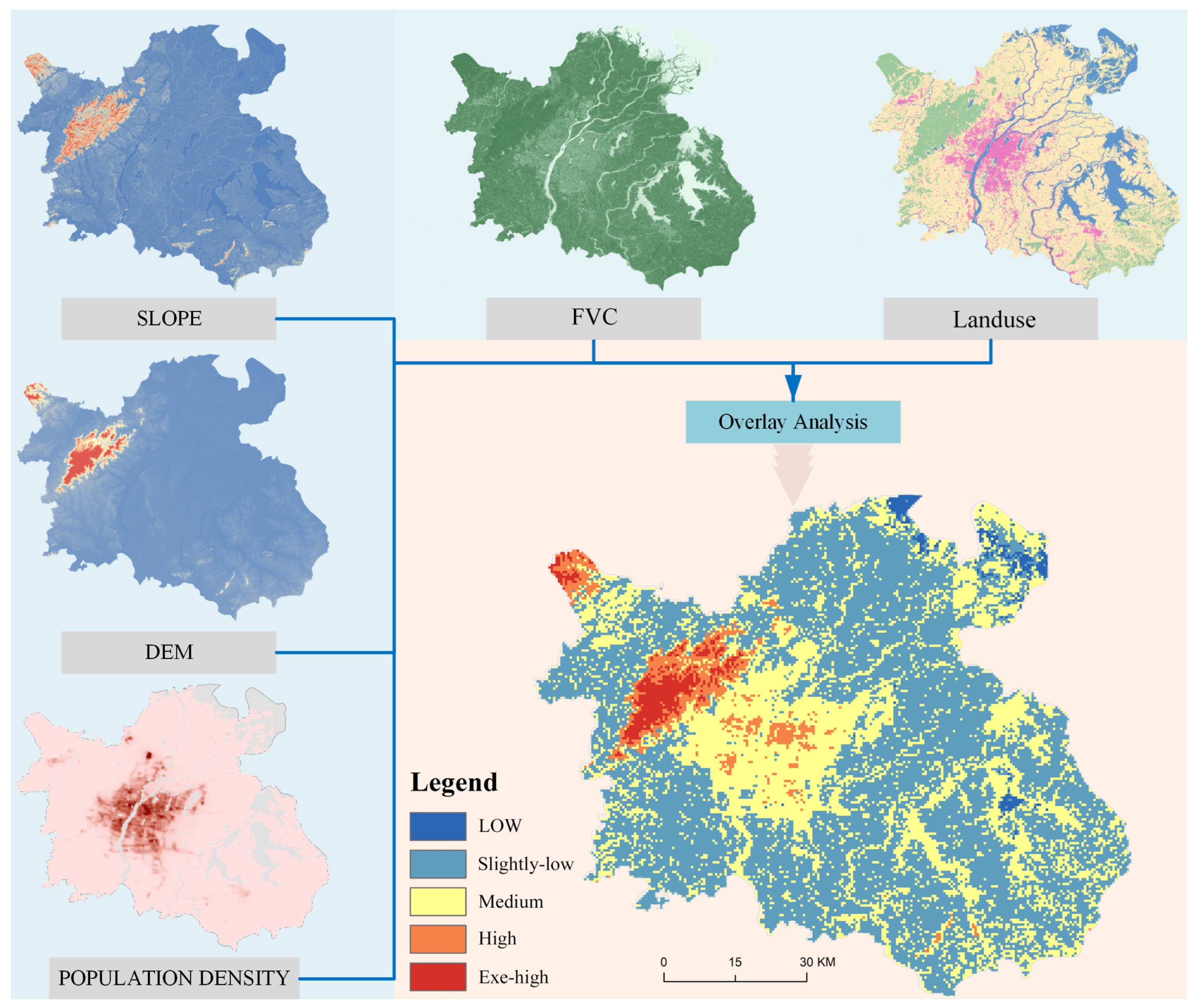
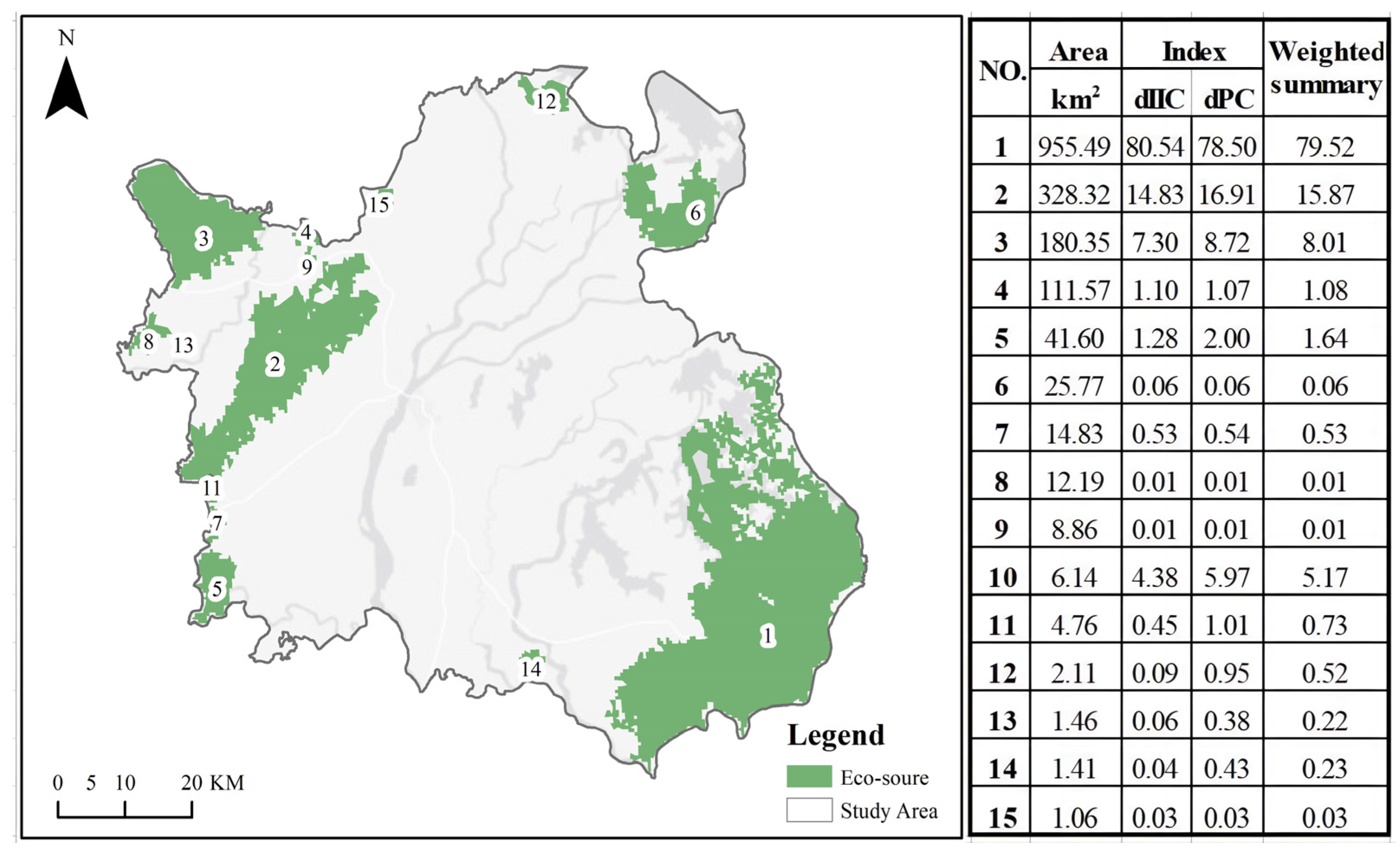
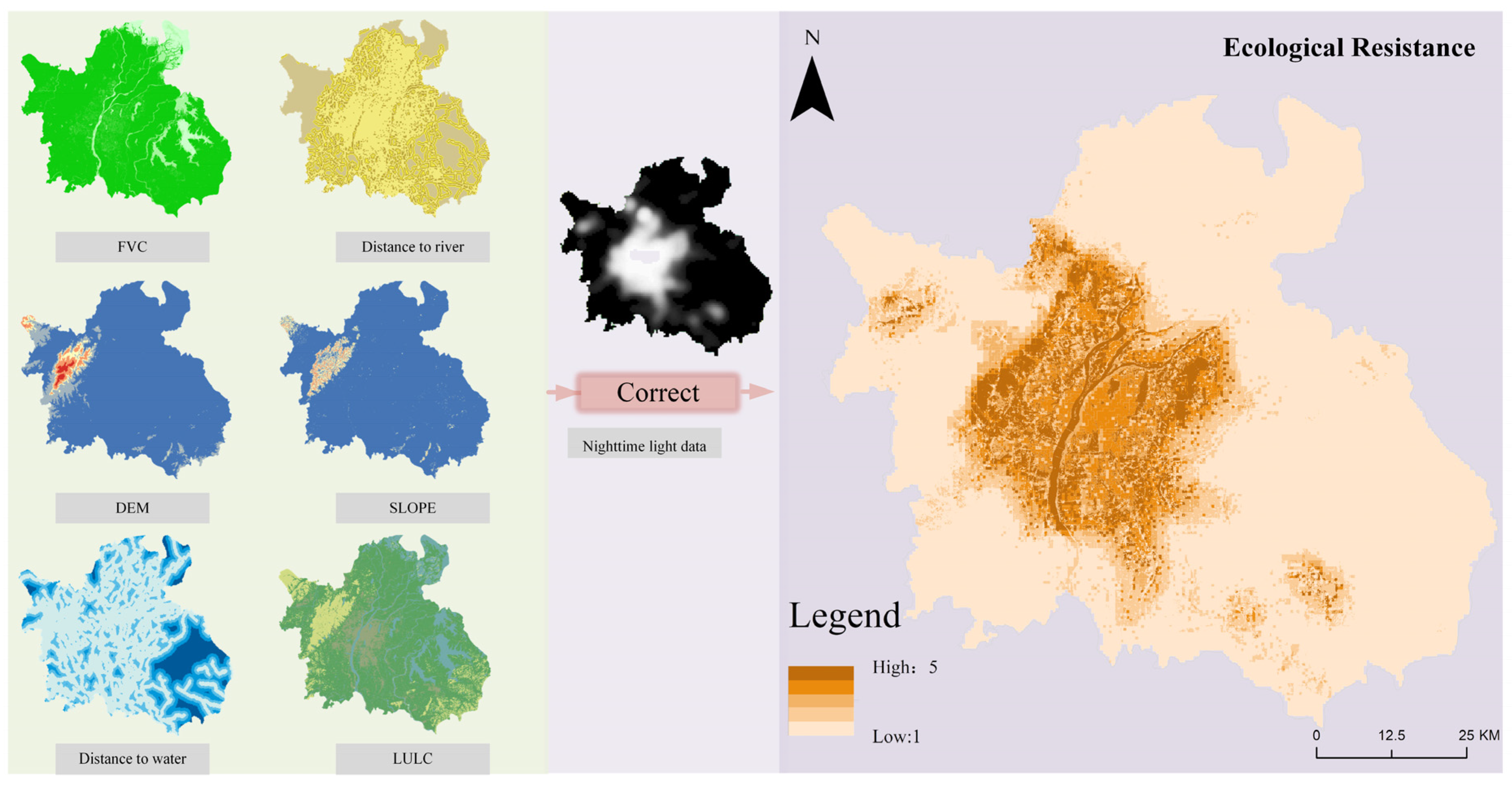
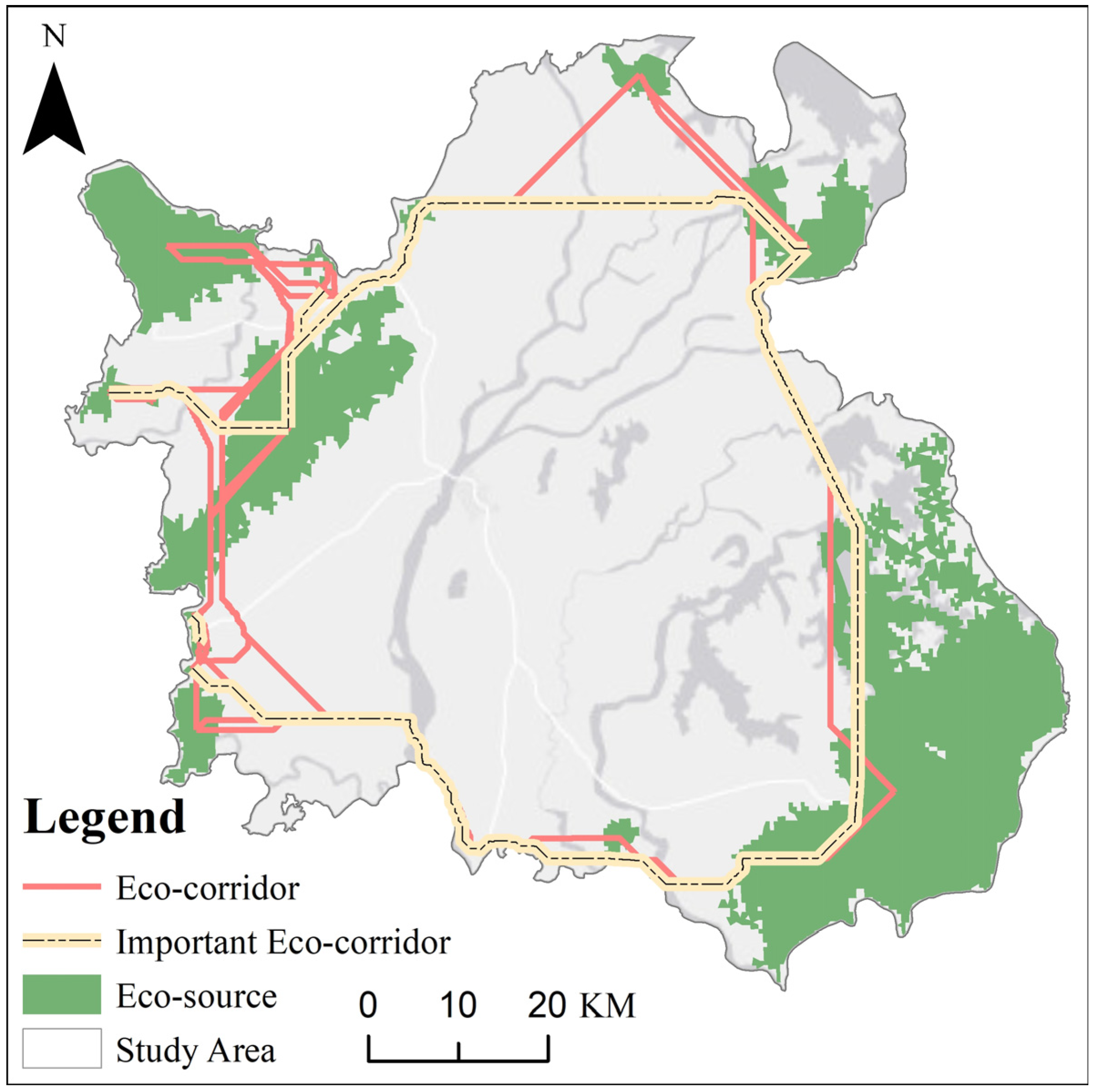
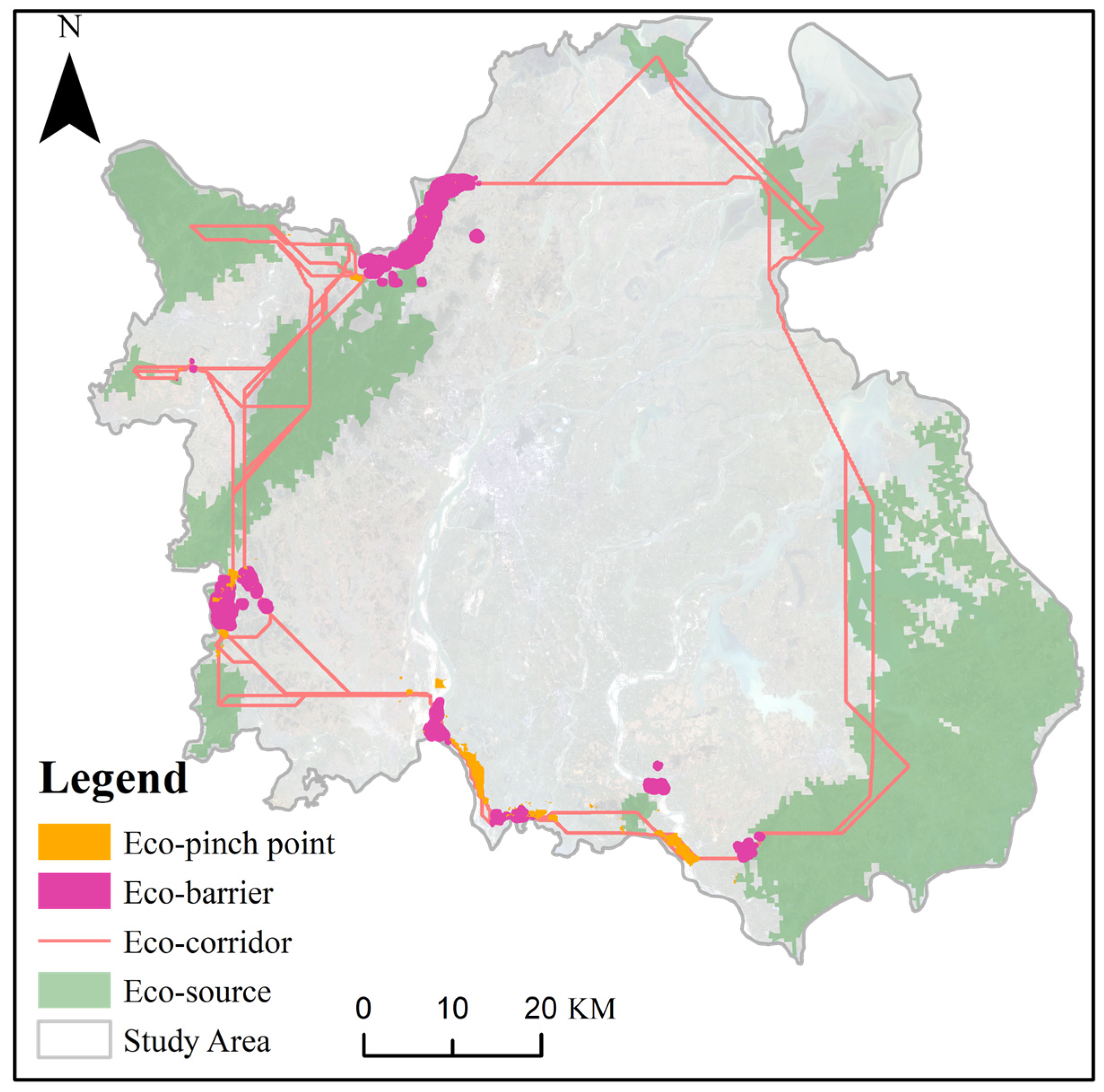
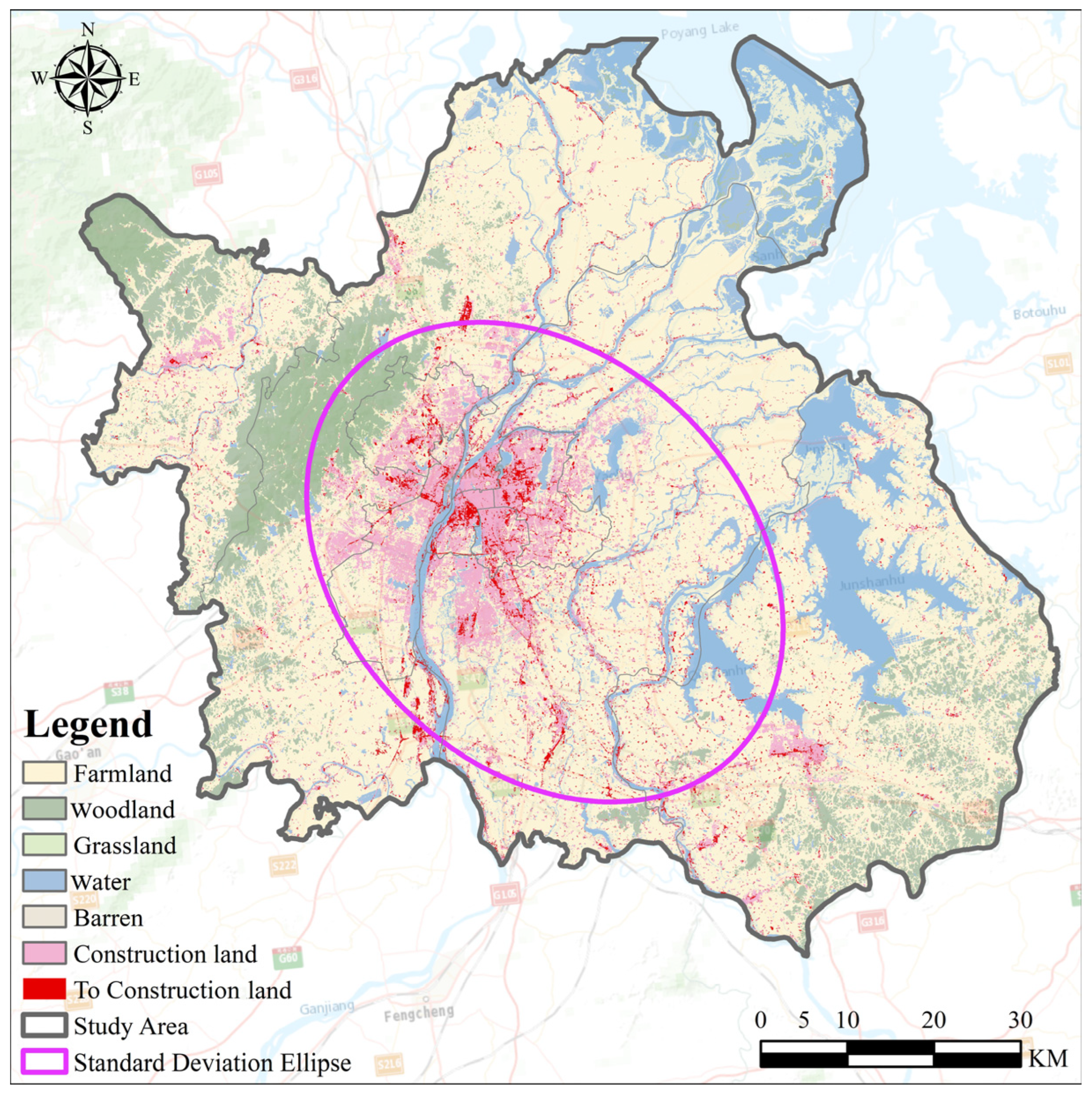
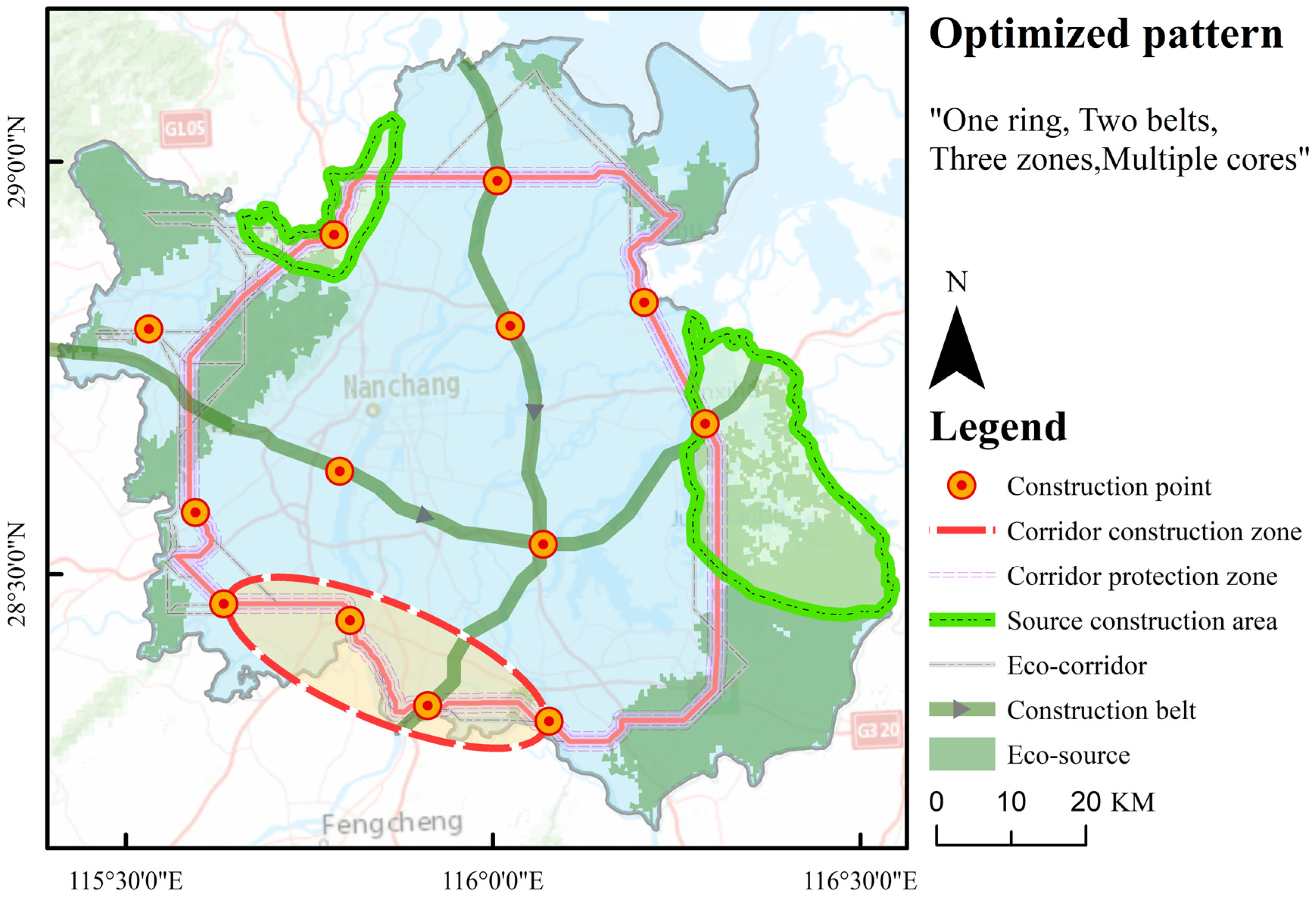
| Type | Data | Time | Date Type | Data Source |
|---|---|---|---|---|
| Landuse | CLCD | 1990–2020 | Raster (30 m) | https://www.globallandcover.com, accessed on 23 April 2023 |
| Natural factors | Elevation | 2020 | Raster (30 m) | https://www.gscloud.cn, accessed on 23 April 2023 |
| Slope | ||||
| Fractional vegetation cover | Landsat satellite data, accessed on 23 April 2023 | |||
| Water system data | Vector | https://www.tianditu.gov.cn, accessed on 23 April 2023 | ||
| River system data | ||||
| Soil thickness and soil structure | Raster (1 km) | http://www.cnern.org.cn, accessed on 23 April 2023 | ||
| Potential evapotranspiration | http://www.cnern.org.cn, accessed on 23 April 2023 | |||
| Administrative boundary | Vector | https://www.resdc.cn, accessed on 23 April 2023 | ||
| Socio-economic factors | Basic road geographic information | 2020 | Vector | https://openstreetmap.org, accessed on 23 April 2023 |
| Nighttime light data | Raster (1 km) | https://www.ngdc.noaa.gov, accessed on 23 April 2023 |
| Factor | Resistance Value | Weights | ||||
|---|---|---|---|---|---|---|
| Level-1 | Level-2 | Level-3 | Level-4 | Level-5 | ||
| Elevation (m) | <50 | 50–150 | 150–250 | 250–500 | >500 | 0.142 |
| Slope (°) | <5 | 5–15 | 15–25 | 25–35 | >35 | 0.167 |
| FVC (%) | >65 | 50–65 | 35–50 | 15–35 | <15 | 0.046 |
| Landuse types | Woodland Grassland | Water | Farmland | Barren | Construction land | 0.467 |
| Distance to river (m) | >1000 | 500–1000 | 200–500 | 100–200 | <100 | 0.121 |
| Distance to water (km) | >10 | 5–10 | 2–5 | 1–2 | <1 | 0.057 |
| Type | Formula |
|---|---|
| Water supply | , where is the annual water volume of the type land grid ; is the average annual evapotranspiration; and is the average annual precipitation. |
| Carbon fixation | , where is the annual carbon holding capacity of land grid × of type j; , , , and are soil organic carbon, aboveground organic carbon, underground organic carbon, and dead organic carbon densities of type land. This study only considered the other three carbon reserves because dead organic carbon data are challenging to obtain. |
| Habitat quality | , where is the habitat quality index of grid in landues type ; is the habitat suitability of landuese type ; is the habitat degradation degree of grid × in landuse type ; is the semi-saturation constant; and is the default parameter of the model. |
| Soil conservation | , where represents soil retention, represents rainfall erosion, represents soil erodibility, represents slope length, represents slope coefficient, represents plant coverage, and represents water and soil conservation. |
| Evaluation Factor | Resistance Value | Weights | |||
|---|---|---|---|---|---|
| Mildly | Low | Moderately | Highly | ||
| Elevation (m) | >500 | 250–500 | 100–250 | <100 | 0.42 |
| Slope (°) | <5 | 5–15 | 15–25 | >25 | 0.06 |
| FVC (%) | <0 | 0–12 | 12–25 | >25 | 0.30 |
| Landuse types | Construction land/ Barren | Farmland | Grassland | Water/ Woodland | 0.14 |
| Population density | >20 | 10–20 | 5–10 | <5 | 0.08 |
| Landuse Types | Area/km2 | Annual Rate of Change | |||||
|---|---|---|---|---|---|---|---|
| 1990 | 2000 | 2010 | 2020 | 1990–2000 | 2000–2010 | 2010–2020 | |
| Farmland | 5127.77 | 4914.43 | 4853.25 | 4534.90 | −0.43% | −0.13% | −0.70% |
| Woodland | 794.17 | 798.75 | 811.97 | 885.71 | 0.06% | 0.16% | 0.83% |
| Grassland | 24.63 | 9.27 | 9.06 | 2.17 | −16.56% | −0.24% | −31.66% |
| Water | 990.28 | 1080.06 | 961.57 | 1028.77 | 0.83% | −1.23% | 0.65% |
| Barren | 12.36 | 11.28 | 5.98 | 3.35 | −0.96% | −8.86% | −7.83% |
| Construction land | 242.12 | 377.54 | 549.46 | 736.38 | 3.59% | 3.13% | 2.54% |
| LC | * | * | * | * | −0.14% | −0.07% | −0.36% |
| Landuse Types | |||||||
|---|---|---|---|---|---|---|---|
| Year | Farmland | Woodland | Grassland | Water | Barren | Construction Land | |
| 1990–2000 | Farmland | 4750.29 | 115.98 | 1.15 | 135.26 | 0.13 | 124.68 |
| Woodland | 110.70 | 681.47 | 0.02 | 0.94 | 0.00 | 0.96 | |
| Grassland | 3.12 | 0.71 | 5.89 | 3.02 | 2.60 | 9.29 | |
| Water | 43.15 | 0.32 | 0.74 | 933.68 | 1.05 | 11.28 | |
| Barren | 0.31 | 0.00 | 1.40 | 2.01 | 7.44 | 1.20 | |
| Construction land | 6.62 | 0.19 | 0.08 | 5.07 | 0.04 | 230.10 | |
| 2000–2010 | Farmland | 4549.40 | 105.87 | 2.31 | 96.08 | 0.16 | 160.39 |
| Woodland | 111.31 | 681.89 | 0.24 | 1.06 | 0.00 | 4.17 | |
| Grassland | 1.36 | 0.11 | 2.74 | 2.11 | 0.56 | 2.39 | |
| Water | 183.05 | 23.78 | 1.64 | 850.69 | 1.57 | 19.11 | |
| Barren | 0.43 | 0.00 | 1.95 | 3.63 | 3.63 | 1.63 | |
| Construction land | 7.45 | 0.22 | 0.18 | 7.88 | 0.05 | 361.76 | |
| 2010–2020 | Farmland | 4342.94 | 167.28 | 0.16 | 159.90 | 0.05 | 182.61 |
| Woodland | 78.93 | 717.02 | 0.01 | 12.68 | 0.00 | 3.24 | |
| Grassland | 2.40 | 0.20 | 0.98 | 2.01 | 0.48 | 2.99 | |
| Water | 100.46 | 0.71 | 0.29 | 841.65 | 0.78 | 17.57 | |
| Barren | 0.48 | 0.00 | 0.67 | 1.78 | 1.96 | 1.08 | |
| Construction land | 9.45 | 0.37 | 0.05 | 10.60 | 0.08 | 528.89 | |
| Sensitivity Evaluation | Area/km2 | Proportion/% |
|---|---|---|
| Low | 4817.70 | 66.99% |
| Slightly low | 1201.54 | 16.71% |
| Medium | 532.89 | 7.41% |
| High | 453.38 | 6.30% |
| Exe-high | 185.82 | 2.58% |
| Sum | 7191.33 | 100.00% |
Disclaimer/Publisher’s Note: The statements, opinions and data contained in all publications are solely those of the individual author(s) and contributor(s) and not of MDPI and/or the editor(s). MDPI and/or the editor(s) disclaim responsibility for any injury to people or property resulting from any ideas, methods, instructions or products referred to in the content. |
© 2023 by the authors. Licensee MDPI, Basel, Switzerland. This article is an open access article distributed under the terms and conditions of the Creative Commons Attribution (CC BY) license (https://creativecommons.org/licenses/by/4.0/).
Share and Cite
Gong, D.; Huang, M.; Lin, H. Construction of an Ecological Security Pattern in Rapidly Urbanizing Areas Based on Ecosystem Sustainability, Stability, and Integrity. Remote Sens. 2023, 15, 5728. https://doi.org/10.3390/rs15245728
Gong D, Huang M, Lin H. Construction of an Ecological Security Pattern in Rapidly Urbanizing Areas Based on Ecosystem Sustainability, Stability, and Integrity. Remote Sensing. 2023; 15(24):5728. https://doi.org/10.3390/rs15245728
Chicago/Turabian StyleGong, Daohong, Min Huang, and Hui Lin. 2023. "Construction of an Ecological Security Pattern in Rapidly Urbanizing Areas Based on Ecosystem Sustainability, Stability, and Integrity" Remote Sensing 15, no. 24: 5728. https://doi.org/10.3390/rs15245728






